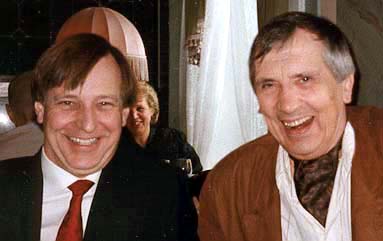
David Pickett & Einojuhani Rautavaara
From 1987 to 1995 I was Music Director of the Bloomington Symphony Orchestra in Indiana, USA. In the course of my tenure I conducted many premières of contemporary music, most of it by Indiana composers. I had first encountered the music of the Finnish composer Einojuhani Rautavaara in 1981, when I heard the cellist Erkki Rautio and pianist Martti Rautio play his Two preludes and fugues on the name EinAr EnGlunD and BÉla BArtók in Weimar, Germany, and I discovered more of his music when I visited Finland in 1987.
In preparing to conduct Rautavaara’s Cantus Arcticus in 1990, I took advantage of being in Helsinki as a participant in the First International Sibelius Conference to meet him and ask his advice over several details. Cantus Arcticus was well received in Bloomington, as was Rautavaara’s Third Symphony, and I continued to meet the composer whenever I was in Helsinki. Emboldened by his collegial and friendly personality, in 1994 I asked him to compose for me a symphony to celebrate the 25th anniversary of the orchestra’s foundation. I asked him for a work that did not demand more players than we could muster, and with enough challenges to keep them engaged throughout — no counting 200 bars rest and coming in cold! To my great delight, Rautavaara agreed to these conditions.
Back in Bloomington, I raised the funds to pay for the commission and conducted the world première of the symphony on 23 April 1995. At that time, neither I or the composer realized how popular this Symphony would become.
Although the work was known initially as The Bloomington Symphony, Rautavaara had a hidden association that he only revealed later when he called it by the more universal name of Angel of Light, connecting it with other works of his about angels. Although this connection was in his mind as he composed, he was reluctant to use the title publically. But when he told the head of his record company the latter insisted, saying “With that title I can sell the recording!” And sell it did. The recording, by the Helsinki Philharmonic Orchestra, garnered several awards, Rautavaara’s international reputation soared, and his next symphony was commissioned by the Philadelphia Orchestra.
However, the Bloomington link is still embedded within the actual notes of the symphony, since the thematic material is based on an acrostic transformation of the words “Bloomington Symphony Orchestra” in a kind of soggetto cavato technique. This is the same device that Rautavaara had used in 1955 for his Two Preludes and Fugues for cello and piano that I had heard in Weimar. The process is to write out some significant words and then pick out in order those letter that can be used to construct a musical theme, as Robert Schumann did in his ABEGG Variations and other compositions.

As shown above, the letters of the words “Bloomington Symphony Orchestra” that can be notated musically are placed on the staff and form the theme. (In Finland, as in Germany, Es (or S) = E-flat, B = B-flat, and H = B-natural.)
Slim pickings you might think: just nine notes out of 28 letters, and it is not the most singable of tunes. But it works on the orchestra! The first appearance is near the beginning of the symphony, broken up into small motifs and played by glockenspiel and vibraphone. Before long, the whole theme is played in all its glory by french horns and trumpet:

…and in various transformations it continues to appear throughout the symphony.
In an interview with the magazine Fanfare (issue of July/Aug 1996), Rautavaara said: As to the Seventh Symphony, I don’t think I would have composed it — at least, not at that time — without David Pickett…
I am proud to have been the catalyst that helped bring this great musical composition into the world.
© David Pickett and davidpickett, 2009. Unauthorized use and/or duplication of this material without express and written permission from this blog’s author and/or owner is strictly prohibited. Excerpts and links may be used, provided that full and clear credit is given to David Pickett and davidpickett with appropriate and specific direction to the original content.
Hi David, Rautavaara’s 7th symphony is one of my favorites. Thanks for giving him the spark to create it. I am an avid horn player since 1960 and just learned of his music about a year ago. I have since obtained recordings of all of his major orchestral works and enjoy all of them, especially his Symphonies, Manhattan Trilogy, Isle of Bliss, Angels & Visitations, Aphrodyte, and his Piano, Brass, String and Vocal pieces and his concertos. Wish he had written one for horn, as his horn passages are to die for. Keep up the good work, I’ll be sure to read your Mahler writings. Richard
Thank you for your support, Richard. Making this commission a reality was a labour of love that was well-worth the effort.